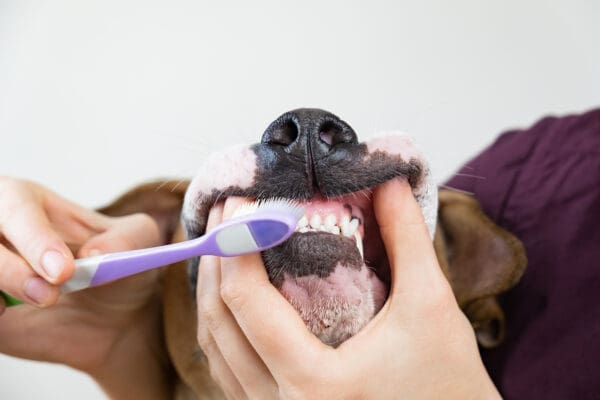Have you ever wondered if there are certain types of dog foods that are better than others? Well, considering that, as pet owners, we invest quite a lot of money over the course of their lives, it’s a very valid concern and one that deserves a detailed explanation. Not only are there several types of dog food, but within each type is a wide array of brands making it even more difficult to know which is best. For example, are those really expensive brands worth the money or are the less expensive brands just as good? Well, we’d like to break it down for you and make the process of choosing a little easier.
Basically, there are five different types of dog food, dry, canned, semi-moist, homemade and raw dog food. What you choose to feed your dog is really up to you, but here are some facts that you’ll want to know in order to make the most informed choice for your pet.
Dry Dog Food
Dry food is the most economical type of commercial dog food, and this is the reason that many owners chose it for their dog. It also lasts for a long time and does not need to be refrigerated. Dry food can also help to keep your dog’s teeth healthy, since chewing crunchy dry food helps to reduce tartar buildup. When it comes to choosing a specific dry food, read the ingredients carefully, and choose a brand that uses meat as the primary ingredient and that it is clearly labeled such as chicken, turkey, lamb, beef. It’s important to note that any meat ingredient should be followed by a “by-product.” For example, if chicken is the first ingredient, you’ll want to see that ingredient followed by either chicken meal, or chicken by-product. The meat ingredients can have a lot of water in them while the by-products have little water in them making them more concentrated sources of protein. Protein is a very necessary part of a dog’s diet so whatever food you choose, make sure that an animal based protein is within the top three ingredients.
Canned Dog Food
Most dogs love the taste of canned dog food. It is typically more expensive than dry food but it does have a long shelf life. The most important thing to remember when choosing a canned dog food is to pick a brand that has the highest amount of digestible protein. Indigestible protein will simply go through your dog’s digestive system and not provide the nutrients that he needs. Also, a lot of canned dog food is about 75% water and this high water content also makes it less nutritious for your dog. If you prefer to feed your dog canned dog food, look for a brand that is labled “100% nutritionally complete” in order to ensure that your dog is getting a high level of nutrition. Also, canned dog food can be slightly higher in calories than dry dog food, which is something to consider, particularly if your dog is less active.
Semi-moist Dog Food
Semi-moist dog foods are typically shaped like a pork chop or a burger and are a cross between dry and canned dog food. They are also the least nutritious because they contain a high level of preservatives and artificial colors. Due to the low level of nutrients in these types of foods, it is best to offer them as an occasional treat rather than given as a steady diet.
Home-cooked Dog Food
A home-cooked diet allows the owner to know for certain exactly what is in everything their dog eats and to be absolutely sure that his nutritional needs are being met. Feeding your dog a home-cooked diet is time consuming and expensive, but many owners think the extra effort is worth the peace of mind they gain. If you decide to feed your dog a home-cooked diet, make sure you are well acquainted with the vital nutrients your dog will need so that you can ensure he is getting proper nutrition.
Raw dog food
A raw diet consists of raw meat, preferably with some bones (never cooked bones, only raw) and organs mixed in, as bones are a natural source of phosphorus and calcium. This type of diet works well for many dogs, since dogs have short intestinal tracts and strong stomach acids, both of which make it easy for them to consume and digest raw food. Before transitioning your dog to a raw diet, talk to your veterinarian about the benefits and risks.
Essential Nutrients for Dogs
As mentioned above, it’s important to know that your dog is getting their vital nutrients, so let’s discuss what those vital nutrients are and then you’ll know you’re making a more informed decision about their food.
Water
Dogs need plenty of water every day to help with the following body functions.
- Stay hydrated
- Regulate body temperature
- Aid digestion
- Lubricate muscle tissues
- Flush away bacteria that cause urinary tract infections
- Ease constipation by moving stools along more smoothly
- Transport oxygen and nutrients throughout the body
Proteins
Proteins build and maintain muscles, organs, bones, blood, body tissues, hair, nails, and the immune system. Many foods contain protein, but the best sources are beef, poultry, fish, eggs, dairy products, grains, and soy.
Signs of protein deficiency:
- Dry, brittle fur
- Poor muscle development
- Anemia
- Growth problems
- Weakened immune system
Fats
Fats are the main source of dietary energy (or calories) in a dog’s diet and provide the most concentrated source of energy in foods. One gram of fat contains more than twice the energy than one gram of protein or carbohydrate. They are needed for healthy skin, coat, eyes, brain, and other tissues.
Healthy fats come from sources such as:
- Chicken fat
- Lamb fat
- Sunflower oil
- Herring oil
Carbohydrates
Carbohydrates are one of the three major nutrients in food and a major source of energy for a dog’s body. Dogs can’t digest uncooked grain as easily as meats, so if grains are fed, it is important to cook them to increase digestibility. Simmer rice or other grains until they are soft. To add a little extra flavor, cook them in chicken or beef broth.
Good sources of carbohydrates include:
- Rice
- Corn
- Potatoes
- Barley
- Whole grain breads and other grains
Vitamins and Minerals
One thing a dog’s body can’t do on its own is make vitamins (though vitamin C is an exception). Vitamins and minerals such as calcium, iron, and magnesium are essential nutrients that can be found in the following foods:
- Bread
- Dairy products
- Fish
- Fruits and vegetables
- Grains
- Milk
Fatty Acids
Dogs require one essential fatty acid (linoleic acid), which is a type of omega- 6 fatty acid. Linoleic acid helps the body to:
- Regulate the blood flow to body tissues
- Clot blood after an injury
- Reproduce normally
- Respond to injury and infection by boosting the immune system
- Maintain a handsome coat and healthy skin
This fatty acid is found primarily in grains and animal fat, and is provided at appropriate levels in high- quality dog foods.
We hope you have found this information to be helpful, however if you still have questions about your dog’s nutrition, talk to your veterinarian. Your vet is always the best source of information regarding your pet’s health and nutrition.



